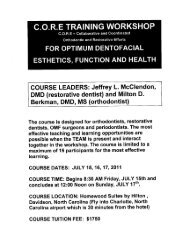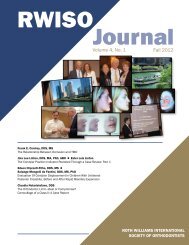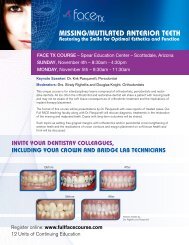2010 RWISO Journal - Roth Williams International Society of ...
2010 RWISO Journal - Roth Williams International Society of ...
2010 RWISO Journal - Roth Williams International Society of ...
Create successful ePaper yourself
Turn your PDF publications into a flip-book with our unique Google optimized e-Paper software.
Condylar Resorption, Matrix Metalloproteinases,<br />
and Tetracyclines<br />
Michael J. Gunson, DDS, MD ■ G. William Arnett, DDS, FACD<br />
mic h a e L J. Gu n S o n , ddS, md<br />
gunson@arnettgunson.com<br />
■ Graduated from UCLA School <strong>of</strong><br />
Dentistry, 1997<br />
■ Graduated from UCLA School <strong>of</strong><br />
Medicine 2000<br />
■ Specialty Certificate in Oral and<br />
Maxill<strong>of</strong>acial Surgery UCLA, 2003<br />
G. Wi L L i a m aR n e T T , ddS, Facd<br />
■ Graduated from USC School <strong>of</strong><br />
Dentistry, 1972<br />
■ Specialty Certificate in Oral and<br />
Maxill<strong>of</strong>acial Surgery UCLA, 1975<br />
Introduction<br />
Orthodontists and maxill<strong>of</strong>acial surgeons are well acquainted<br />
with the effects <strong>of</strong> condylar resorption (Figure 1).<br />
Figure 1 Tomograms reconstructed from cone-beam CT scan.<br />
They show severe condylar resorption in a 19-year-old female<br />
over a 2-year period. Note the progressive osseous destruction.<br />
The clinical outcomes <strong>of</strong> condylar resorption have been described<br />
at length in the literature. 1-6 The causes, however,<br />
have been elusive, hence the common name idiopathic condylar<br />
resorption. Over the last several years, the pathophysiology<br />
<strong>of</strong> articular bone erosion secondary to inflammation<br />
Summary<br />
Mandibular condylar resorption occurs as a result <strong>of</strong> inflammation and hormone<br />
imbalance. The cause <strong>of</strong> the bone loss at the cellular level is secondary<br />
to the production <strong>of</strong> matrix metalloproteinases (MMPs). MMPs have been<br />
shown to be present in diseased temporomandibular joints (TMJs). There is<br />
evidence that tetracyclines help control bone erosions in arthritic joints by<br />
inactivating MMPs. This article reviews the pertinent literature in support <strong>of</strong><br />
using tetracyclines to prevent mandibular condylar resorption.<br />
has been well studied. A number <strong>of</strong> cytokines and proteases<br />
are found in joints that show osseous erosions that are not<br />
present in healthy joints, namely TNF-α, IL-1β, IL-6, and<br />
RANKL and matrix metalloproteinases.<br />
Matrix Metalloproteinases<br />
MMPs are <strong>of</strong> interest because they are directly responsible<br />
for the enzymatic destruction <strong>of</strong> extracellular matrix in normal<br />
conditions (angiogenesis, morphogenesis, tissue repair)<br />
and in pathological conditions (arthritis, metastasis, cirrhosis,<br />
endometriosis). MMPs are endopeptidases that are made<br />
in the nucleus as inactive enzymes, or zymogens. The zymogens<br />
travel to the cell membrane, where they are incorporated.<br />
The zymogen is then cleaved into the extracellular matrix<br />
as the active enzyme, where it makes cuts into the protein<br />
chains (collagen types I through IV, gelatin, etc). These cuts<br />
cause the proteins to denature, which results in the destruction<br />
<strong>of</strong> the matrix. The action <strong>of</strong> the MMP requires the mineral<br />
zinc—which is an important part <strong>of</strong> the MMP’s protein<br />
structure; hence the name metalloproteinase (Figure 2).<br />
<strong>RWISO</strong> <strong>Journal</strong> | September <strong>2010</strong><br />
37








